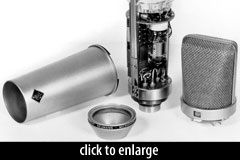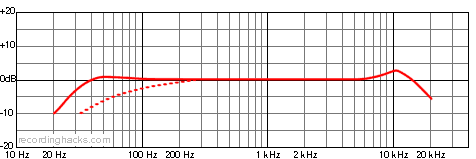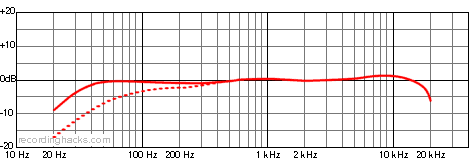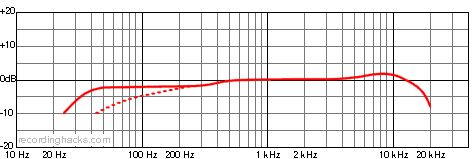

 Neumann U 67
Neumann U 67
Multi-Pattern Tube Condenser Microphone
The Neumann U 67 is a multipattern large-diaphragm condenser microphone with a tube-and-transformer topology. It was introduced by Neumann in 1960 with the intention of replacing the U 47 in Neumann’s product line.
 The new microphone, originally christened the U 60 for the year of its development, brought numerous innovations to market.
The new microphone, originally christened the U 60 for the year of its development, brought numerous innovations to market.
The K67 capsule, which since 1960 has become the most common and most copied condenser capsule in the world, was designed to avoid the challenges and costs of tuning the K47 so that both diaphragms produce identical frequency responses. Unlike the K47, the K67 utilizes a two-piece backplate, allowing the diaphragms to be tuned individually and then matched for equivalent response.
A -10dB pad was incorporated, in response to the trend of placing microphones closer to sources.
For the same reason, the mic had a switchable high-pass filter to roll off low frequencies. The Neumann manual gives a 100Hz corner frequency, but the published graphs show attenuation as high as 300Hz. In addition, a fixed 30Hz rolloff was incorporated into the amplifier circuit to reduce pickup of mechanically transmitted noise (rumble).
According to Roessler, the tapered body shape was purely a cosmetic change, intended to satisfy an increasingly style-conscious market. This body design is also used for the U87 and U87A microphones.
The tube was a Telefunken EF86, a pentode wired into this circuit as a triode. It used a 6.3V filament voltage, and was wired to the PCB via a Teflon socket.
The mic’s output transformer is somewhat unique. According to David Bock, “it uses a tertiary winding for negative feedback through the capsule to the tube.”
 An initial production run of approximately 20 microphones was labeled and sold as the “U 60.” All of these reportedly used the K67 capsule, but according to Klaus Heyne, a variety of prototype mounting methods were employed, such as the wire wrap pictured at right.
An initial production run of approximately 20 microphones was labeled and sold as the “U 60.” All of these reportedly used the K67 capsule, but according to Klaus Heyne, a variety of prototype mounting methods were employed, such as the wire wrap pictured at right.
Neumann reportedly produced a reissue of the U67 sometime in the late 1980’s or early 1990’s. According to the late Stephen Paul, the reissue U67s suffered from what he characterized as reduced tolerances on the CNC-lathed K67 capsule. The reduced tolerances affected the capsule’s high-frequency response.
Nonetheless, Neumann staff maintain that the reissue U67 was identical to the original in every way but one — the output connector differed.
The original U 67 shipped with its dedicated power supply, p/n NU 67.
The Neumann U 67 is also known as: U 60, U67.
The mic was released in 1960.
Specifications
| Frequency Response - OmnidirectionalClick Graph to Compare! |
|---|
 |
| Frequency Response - CardioidClick Graph to Compare! |
 |
| Frequency Response - BidirectionalClick Graph to Compare! |
 |
| Pickup Patterns | Pads & Filters |
|---|---|
|
Omnidirectional
(11 mV/Pa; 30 - 16,000 Hz) Cardioid (20 mV/Pa; 30 - 16,000 Hz) Bidirectional (14 mV/Pa; 30 - 16,000 Hz) |
|
| Capsule Dimensions | Impedance | SPL/Noise |
|---|---|---|
| Diameter n/a Diaphragm gauge: 6 microns |
200 Ohms (Low) | Max SPL: 116 dB |
| Weight | Length | Max Diameter | Interface(s) |
|---|---|---|---|
| 540g (19.05oz) | 201mm (7.91'') | n/a |
|
| Power Specifications |
|---|
|
Did we get anything wrong on this page? Please let us know!












